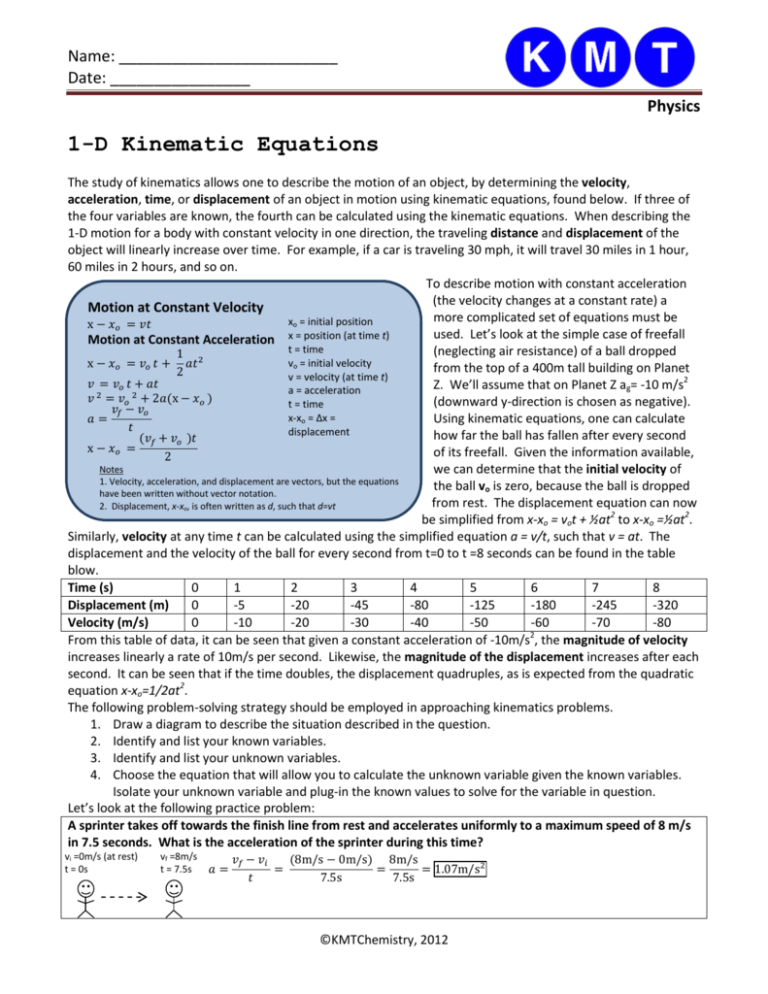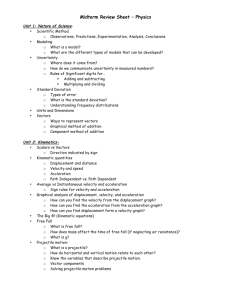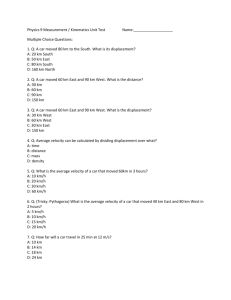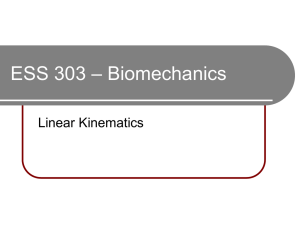1-D Kinematic Equations - KMT Chemistry
advertisement

Name: _________________________ Date: ________________ Physics 1-D Kinematic Equations The study of kinematics allows one to describe the motion of an object, by determining the velocity, acceleration, time, or displacement of an object in motion using kinematic equations, found below. If three of the four variables are known, the fourth can be calculated using the kinematic equations. When describing the 1-D motion for a body with constant velocity in one direction, the traveling distance and displacement of the object will linearly increase over time. For example, if a car is traveling 30 mph, it will travel 30 miles in 1 hour, 60 miles in 2 hours, and so on. To describe motion with constant acceleration (the velocity changes at a constant rate) a Motion at Constant Velocity more complicated set of equations must be xo = initial position used. Let’s look at the simple case of freefall x = position (at time t) Motion at Constant Acceleration t = time (neglecting air resistance) of a ball dropped vo = initial velocity from the top of a 400m tall building on Planet v = velocity (at time t) Z. We’ll assume that on Planet Z ag= -10 m/s2 a = acceleration (downward y-direction is chosen as negative). t = time x-xo = ∆x = Using kinematic equations, one can calculate displacement how far the ball has fallen after every second of its freefall. Given the information available, Notes we can determine that the initial velocity of 1. Velocity, acceleration, and displacement are vectors, but the equations the ball vo is zero, because the ball is dropped have been written without vector notation. from rest. The displacement equation can now 2. Displacement, x-xo, is often written as d, such that d=vt be simplified from x-xo = vot + ½at2 to x-xo =½at2. Similarly, velocity at any time t can be calculated using the simplified equation a = v/t, such that v = at. The displacement and the velocity of the ball for every second from t=0 to t =8 seconds can be found in the table blow. Time (s) 0 1 2 3 4 5 6 7 8 Displacement (m) 0 -5 -20 -45 -80 -125 -180 -245 -320 Velocity (m/s) 0 -10 -20 -30 -40 -50 -60 -70 -80 2 From this table of data, it can be seen that given a constant acceleration of -10m/s , the magnitude of velocity increases linearly a rate of 10m/s per second. Likewise, the magnitude of the displacement increases after each second. It can be seen that if the time doubles, the displacement quadruples, as is expected from the quadratic equation x-xo=1/2at2. The following problem-solving strategy should be employed in approaching kinematics problems. 1. Draw a diagram to describe the situation described in the question. 2. Identify and list your known variables. 3. Identify and list your unknown variables. 4. Choose the equation that will allow you to calculate the unknown variable given the known variables. Isolate your unknown variable and plug-in the known values to solve for the variable in question. Let’s look at the following practice problem: A sprinter takes off towards the finish line from rest and accelerates uniformly to a maximum speed of 8 m/s in 7.5 seconds. What is the acceleration of the sprinter during this time? vi =0m/s (at rest) t = 0s vf =8m/s t = 7.5s ©KMTChemistry, 2012 Physics – 1-D Kinematic Equations Answer the following kinematics questions below. Remember that on Earth, ag = -9.81m/s2. 1. A pitcher throws a baseball from the pitcher’s mound to home plate (distance of 18.39m). The ball travels at 40.0 m/s. How long is the ball traveling from the mound to home plate? 2. A car traveling at 35 m/s decelerates uniformly at a rate of 10. m/s2 to a velocity of 25m/s in the same direction. How long does it take for the car to decelerate? 3. Dora drops her backpack outside of her window, 20. meters above the ground. Her friend, Diego, is 10. meters away from the drop point, and is running at constant speed of 3.0 m/s to catch the backpack. Will Diego get there in time? Explain your answer. 4. On Planet Vegeta 3, the acceleration due to gravity is 6.0 m/s2. An astronaut steps off the top of a spaceship on Planet Vegeta 3 and lands on the surface in 3.8 seconds. How tall is the spaceship? 5. Basketball player Lebron has a vertical leap of 44 inches. What is his take off speed (m/s) and hang time? 6. A car uniformly accelerates from 5.0 m/s at a rate of 10. m/s2 to 35m/s. How far does the car travel during this time? ©KMTChemistry, 2012









